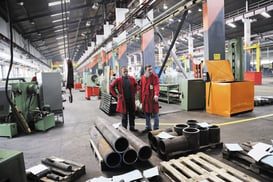
The global coronavirus pandemic has forced manufacturers to make significant changes in the way they do business. Manufacturers will be forced to rely on technology more significantly for inventory forecasting. The companies they deal with as part of their supply chains will also be relying on digital connections in their interactions.
It is a realization most manufacturers came by as they faced profound shocks brought on by the pandemic. Yet, far from being the only culprit, COVID-19 exposed pre-existing cracks in the supply chain. From the accelerated pace of technological change to the constant shift in global business dynamics, we have observed major constraints across the following areas:
- Lack of materials: While materials shortages are not new, they were exacerbated by the surge in demand once pandemic-induced lockdowns blocked off primary avenues for raw materials. Reliance on too few primary suppliers for critical components and materials has compounded the problem even further with unexpected ripple effects on downstream manufacturing as evidenced by the still ongoing global computer chip shortages.
- Labor shortages: Despite record layoffs in many industries, manufacturers face a skills shortage in key positions in operations and across the supply chain. One of the key drivers is the aging workforce leaving for retirement. Adequate cross-training is not occurring fast enough to fill the gap.
- Accelerated consumer demand: The experience of living through COVID-19 changed both our expectations and behavior. For one, the e-commerce sector responded rapidly to the pandemic by creating seamless online experiences. Investments in logistics and supply chains would potentially support wider product ranges, foster time savings, and attract larger numbers of customers. Yet, due to inadequate physical and digital infrastructure, many manufacturers lacked the flexibility they needed to take advantage of accelerated demand and were unable to optimize fulfillment.
- Higher operational costs: All of the above pressures culminate in rising operational costs – from labor, materials, and warehousing, to IT, freight, and safety. Forced to implement protective measures through the pandemic, some companies increased overhead by stockpiling inventory which negatively affects both cash flow and profits.
Better Inventory Forecasting with ERP
All these factors exert enormous influence over manufacturing operations and their supply chains. Rather than enforce survival and stopgap measures going forward, manufacturers are seeking out measures to ensure continuity and dependability in their supply chains.
Manufacturers can use forecasting to support inventory optimization. Gone are the days where you solely had to rely on your sales team to create wishful-thinking forecasts.
An enterprise resource planning (ERP) system can automate and provide a systematic approach to creating a forecast from historical data. It provides the facility to analyze forecasting errors, share data between departments such as procurement, identify sales trends and seasonality. You can even use comparable existing product history as a starting point to model a forecast for a new product. Other related tools such as Pareto analysis identify which products are most profitable and hence those you should focus your attention on.
More Accurate Inventory Forecasting
Manufacturers know that good supplier relationships are critical. Charged with this critical task, the purchasing department can leverage its Material Requirements Plan (MRP) to stay abreast of what’s needed, how much, and when.
MRP looks at the variables that create demand in your system, such as sales orders, forecasts, quotes, and supply, including the inventory of raw materials and finished goods, outstanding purchase orders as well as production jobs. MRP runs this information through a series of algorithms and then makes suggested recommendations for what to buy, how much, when, and from which supplier. Future time parameters can be set, and the recommendations can then be shared with suppliers as a form of forecasting your intentions to purchase.
Suppliers can then use your inventory forecast to refine their own production and procurement plans. Providing them with an accurate forecast ensures not only your intention to purchase but also provides the right details to secure the best pricing and terms.
Get a Holistic View of Your Operation
Designed to give you a holistic view of an enterprise, ERP systems will assist you in managing your data and gaining insights into your business. The full benefits of an ERP are realized when the system is leveraged across all departments:
- Production is able to map out longer-running production jobs, which will translate into higher throughput, fewer changeovers, and lower overtime.
- Sales is more efficient when it can effectively set achievable sales targets and spend more time generating revenue.
- Finance can more effectively analyze profitability by examining how costs can be reduced when the business carries less inventory or by optimizing shipping, for example.
- Purchasing will use forecasting to organize the Purchase Order (PO) system, which enhances its negotiating power when dealing with suppliers.
In a world where global dynamics are constantly shifting, it pays to have technology you can trust. The right ERP, like SYSPRO or Sage 300, gives manufacturers technology they can count on for inventory forecasting. It can help them identify trends and make the changes necessary to adapt to them. Manufacturers can become nimbler—making changes to their supply chains and reaching out to new trading partners when necessary. Companies that master these abilities will be well prepared for whatever comes in 2022 and beyond.
To discover how to use ERP to accurately forecast inventory, contact us today for a discussion.


 © 2019 PositiveVision • 219 E. Thorndale Ave. Roselle, IL 60172
© 2019 PositiveVision • 219 E. Thorndale Ave. Roselle, IL 60172